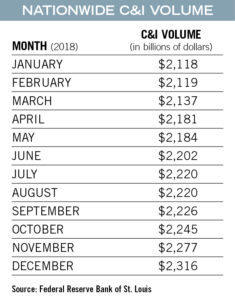Commercial and industrial lending, typically a strong indicator of how the economy is doing, surged in the fourth quarter of 2018, with most banks saying C&I lending was the main driver behind overall loan growth in the quarter.
Most experts expect the trend to continue into 2019. At the same time, the Federal Reserve’s Open Market Committee appeared to decide to hold off on tpreviously predicted two rate hikes in 2019. The move hints that rate hikes might be coming to an end and that the Fed fears the economy might start to slow.
“The trend in C&I is positive in the respect that C&I growth was weak in 2017 and the first half of 2018. Some of the higher growth rates recently reported is C&I coming back to more normal growth levels, as well as growth being better than expected,” Richard Grasfeder, managing director and a senior portfolio manager at Boston Private, told Banker & Tradesman. “There are a lot factors the Fed is going to pay attention to when it comes to deciding whether or not to raise rates.”
Q4 Gave Some 50 Percent Growth
When the corporate tax rate was cut toward the end of 2017, many companies were saving so much money that they didn’t need loans. Now, demand is starting to catch up.
While many community banks enjoyed strong C&I fourth quarters, some institutions’ year-over-year growth would have been less impressive without that bump.
 For instance, at Boston Private, the bank grew C&I lending $135 million year-over-year, $52 million of which came in the fourth quarter.
For instance, at Boston Private, the bank grew C&I lending $135 million year-over-year, $52 million of which came in the fourth quarter.
The parent company of Berkshire Bank grew C&I lending about $177 million year-over-year, $78 million of which happened in the fourth quarter alone. And the parent company of Rockland Trust grew its C&I lending more than $200 million year-over-year, $90 million of which came in the fourth quarter.
American Banker reported that banks holding less than $20 billion of assets increased their loan balances 9.2 percent year-over-year, driven largely by C&I lending in the fourth quarter, according to data compiled by FIG Partners.
C&I growth also was not limited to major hubs like Boston but occurred in areas all over the state.
“I would say that our investments in C&I teams in Fairfield County, Western Massachusetts, Worcester and also the Metro Hartford area, investments we made in late 2014, are continuing to augment growth there,” United Bank’s President and CEO Bill Crawford said on the company’s most recent earnings call.
Will C&I Factor into Fed’s Thinking in 2019?
Positive trends in C&I suggest a positive economy, but other data points could be factoring into the Fed’s decisions.
“Information received since the Federal Open Market Committee met in December indicates that the labor market has continued to strengthen, and that economic activity has been rising at a solid rate,” the FOMC said in their statement on Jan. 30. “Job gains have been strong, on average, in recent months, and the unemployment rate has remained low.”
The FOMC added that it would “be patient” in determining future adjustments to the federal funds rate in light of global economic and financial developments and muted inflation pressures.
Grasfeder believes the main reason the Fed is thinking of halting rate hikes is due to tightening credit conditions more broadly.
A moderate net share of banks in January reported increasing the premiums charged on riskier loans to large and middle-market firms, and a modest net share of banks reported doing so for loans to small firms, according to the Federal Reserve’s senior loan officer opinion survey.
The situation reminds Grasfeder of economic conditions in 2015 and 2016 when then-Fed Chair Janet Yellen held out on raising rates, despite many calls to do so from the industry.
“She was very astute in her decision because global credit was constricting,” he said. “A slower macro backdrop, tighter credit conditions and the Fed raising rates is not a good mix… It makes sense from our perspective for the Fed to pause rate hikes.”

Bram Berkowitz
C&I lending also might eventually begin to slow down in 2019, as tighter lending standards mixed with slower deposit growth results in slower lending.
But if C&I does continue to pick up, Grasfeder said the Fed will have a more difficult time in keeping rates where they are because if smaller businesses see strong returns on future investments, they can then pay more for credit, playing into a cycle where economic growth and inflation rise above healthy levels.






